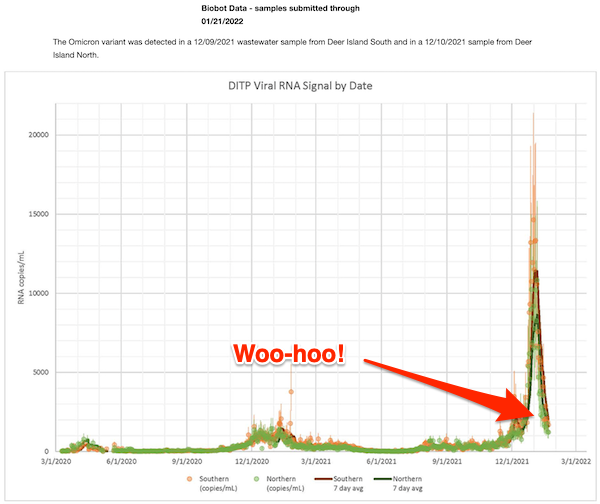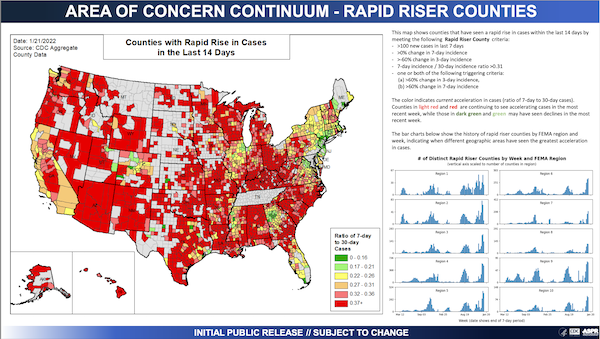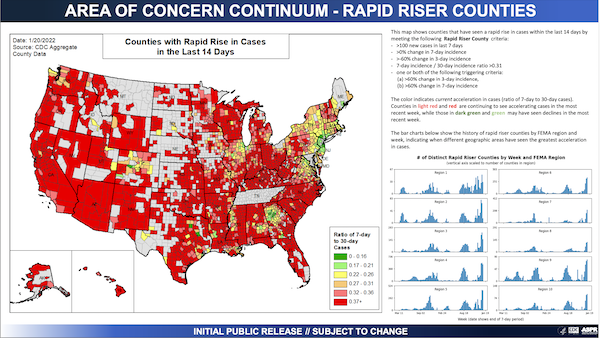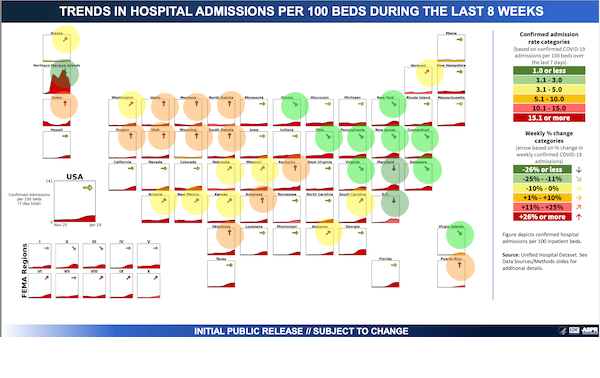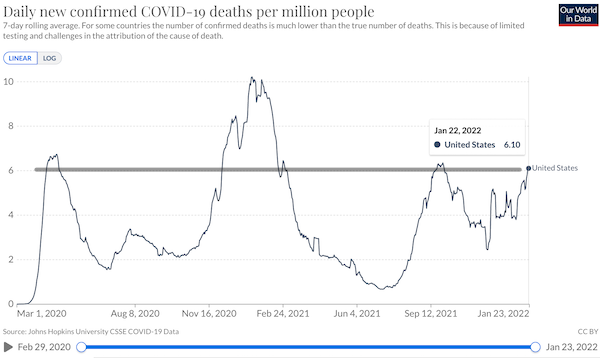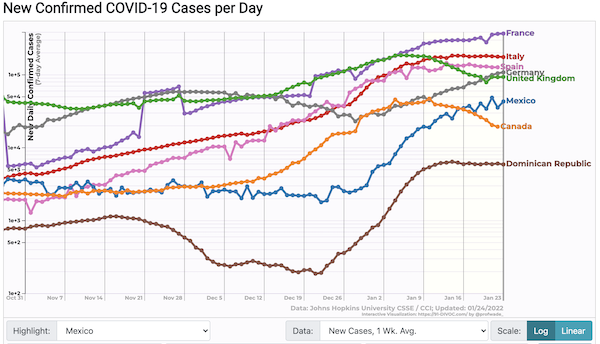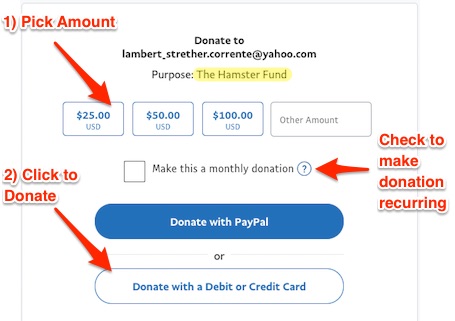[ad_1]
By Lambert Strether of Corrente
Bird Song of the Day
I thought it was time to find some spring songbirds, even if it is only January.
Politics
“But what is government itself, but the greatest of all reflections on human nature?” –James Madison, Federalist 51
“They had learned nothing, and forgotten nothing.” –Charles Maurice de Talleyrand-Périgord
“When the going gets weird, the weird turn pro.” –Hunter Thompson
Biden Adminstration
“Biden’s Pandemic Fight: Inside the Setbacks of the First Year” [New York Times]. I’m checking my thesaurus for “setback,” and “debacle,” “breakdown,” “collapse,” “fiasco,” and “disaster” don’t appear. Odd. A long story, but here is the key paragraph: “Mr. Biden took office last January with a 200-page coronavirus response strategy, promising a ‘full-scale wartime effort’ rooted in science and competence. The C.D.C.’s July discovery [of breakthrough cases in Provincetown] marked the point at which the virus began ruthlessly exposing the challenges it would present to his management of the pandemic.” • The real story is why Biden went Vax-only, and not his 200-page coronovirus strategy*. (For example, a “wartime effort” would have tracked all breakthough infections, which CDC did not do; hence Walensky’s surprise in July. A wartime effort would also have included non-pharmaceutical interventions like standarizing on N95 masks and developing ventilation standards. A wartime effort would also have included Manhattan Project-level — or Operation Warp Speed-level — programs for testing and treatment, including manufacturing. The Biden administration did none of those things. Why? That’s the story, and the Times didn’t get it. NOTE * Remember when Obama — lying, naturally — said Trump ignored the playbook Obama left for him? Well, Biden wrote his own playbook, and then ignored that too!
“Biden Says Russia Can Invade Ukraine So Long As They Avoid Hunter’s Gas Company” [Babylon Bee]. • That’s where we are on Ukraine; I’ve got to quote the Babylon Bee to find something that makes sense.
“How Jen Psaki Manages One of the Most High-Profile Jobs in Washington” [New York Magazine]. On facing public criticism: “I had a little flavor of this when I was the State Department spokesperson, because the Russian propaganda machine decided that I was going to be one of the top enemies…” • I can’t imagine the Kremlin’s dossier of “top enemies” has Psaki’s file in it. This is West Wing brain. And from one of my favorite accounts:
Mrs. Nixon’s recipe is excellent. In fact it has been printed. https://t.co/tS9pOddiAP
— Richard M. Nixon (@dick_nixon) January 22, 2022
Democrats en Déshabillé
I have moved my standing remarks on the Democrat Party (“the Democrat Party is a rotting corpse that can’t bury itself”) to a separate, back-dated post, to which I will periodically add material, summarizing the addition here in a “live” Water Cooler. (Hopefully, some Bourdieu.) It turns out that defining the Democrat Party is, in fact, a hard problem. I do think the paragraph that follows is on point all the way back to 2016, if not before:
The Democrat Party is the political expression of the class power of PMC, their base (lucidly explained by Thomas Frank in Listen, Liberal!). ; if the Democrat Party did not exist, the PMC would have to invent it. . (“PMC” modulo “class expatriates,” of course.) Second, all the working parts of the Party reinforce each other. Leave aside characterizing the relationships between elements of the Party (ka-ching, but not entirely) those elements comprise a network — a Flex Net? An iron octagon? — of funders, vendors, apparatchiks, electeds, NGOs, and miscellaneous mercenaries, with assets in the press and the intelligence community.
Note, of course, that the class power of the PMC both expresses and is limited by other classes; oligarchs and American gentry (see ‘industrial model’ of Ferguson, Jorgensen, and Jie) and the working class spring to mind. Suck up, kick down.
* * * “Democrats Gird Themselves to Give Manchin Exactly What He Wants” [Rolling Stone]. “But what’s happening this time around doesn’t resemble the rounds of negotiations Democrats endured in the first year of Biden’s presidency. Instead, they seem resigned to build legislation around the whims of their fickle colleague from West Virginia. ‘We should pass whatever can pass — it’s as simple as that,’ Sen. Brian Schatz (D-Hawaii) says. ‘We are all using our brains and our egos to make this more complicated than necessary.’ … The whole process is a tough pill for the president to swallow: This next phase will put another deep cut in the transformational change he and his party pitched, and far from what Democrats had hoped to achieve in their once-in-a-long time unified control of government. ” • Not with a bang but a whimper….
Manchin is doing just fine, thank you:
These are honestly incredible numbers for Manchin. If you want to know why he is the way he is, it seems to be working. #WVSen https://t.co/P5Utp9HHYC
— Eric Michael Garcia (@EricMGarcia) January 21, 2022
“The Memo: Biden looks for way to win back deflated Black voters” [The HIll]. “The president’s belated push for voting rights legislation crescendoed with a big speech in Atlanta on Jan. 11 — and faded out just as fast. The cause of police reform has slipped away, too. Congressional efforts to reach a bipartisan deal on the issue went nowhere last year. Biden quietly abandoned a campaign pledge to create a national police oversight commission back in April…. There are plenty of signs of trouble. An NBC News poll released Thursday showed Biden’s approval rating among Black Americans having slid markedly, to 64 percent approval now from 83 percent nine months ago. Other surveys have shown broadly similar trends for a while. A HIT Strategies poll in November showed Biden’s net approval among Black voters slipping from +76 percent to +66 percent since June. The numbers speak to a disappointment some Black voters feel with Biden, especially given that support from within their community was so crucial to putting him where he is. Now, some are wondering what their community has got in return.” • The missing six hundred bucks turned out to be a great metaphor, didn’t it?
2022
* * *
2024
Realignment and Legitimacy
I apologize for the prolixity of the following. But they’re all worth reading in full, each in their own way:
“The Reality of Denial and the Denial of Reality” [The Reality of Denial and the Denial of Reality]. “The inherent divisions and antagonisms of capitalist society will always be reflected in its political form, i.e. the state. When these contradictions are imposed through repressive measures, the (also inherent) anti-state sentiments will reach the surface and explode in divergent forms of opposition. Fetishising these oppositions, however, while neglecting their underlying content, renders critique incapable of recognising a historical truth: namely, that opposition to a state of affairs can just as easily be reactionary, a category not exclusive to organised fascists (though they are clearly not far). The necessary opposition to the state and its management loses its emancipatory potential when construed as an expression of indifference towards a real threat, largely premised on the illusion that specific individualities (usually, healthy young bodies) see themselves as being beyond risk. Resisting effective precautionary measures against an airborne virus in the name of a conceptualisation of freedom that pre-emptively excludes vulnerable (i.e. proletarian) categories cannot be the ground for a radical questioning of existing society. The decomposition of collective existence and resistance through repression and austerity, responsible for producing the underlying framework within which contemporary anti-mask, anti-vaxx mobilisations take place, cannot be recomposed by appealing to the emptiness of individual autonomy in the face of a collective menace.”
“End America’s Institutional Provincialism” [Liberal Currents]. “One of the global trends of the past two centuries across systems of every type—not just liberal democracies—was the rise of political parties as the chief means of organizing political power. The drafters of the Constitution famously failed to take this into account, despite the fact that parties of a certain sort were already a key element in British parliamentary government. But the party of Burke, and of the Hamiltonian Federalists, were nothing like the enormous national organizations that would emerge in the 19th century, and reach their zenith in the early 20th century. The American situation with respect to parties is extremely unique. In particular, the fact that candidates are by and large selected through primary elections imposed on our parties by state laws and administered by public officials. No other country in the world has primaries with such broad citizen participation. In most other systems in the world, parties nominate their own candidates with a fairly small circle of insiders. At the outer limit, in Israel and Belgium for example, there are closed primaries in which dues paying members cast votes. In America, for “closed” primary states, one need only make sure to register for a party with the state in advance. There is no other criteria for participation. And in some states, of course, there are “open” primaries in which even this is not a requirement. As a result, there really are no formal party organizations for any functional meaning of the term. There are informal factions that have the most sway on specific local primaries, and there is a party “brand” that our media environment has turned almost entirely national, where it used to be subject to a great deal of local variation (and hence congressional parties used to be quite heterogeneous in their policy positions). While there are no strong parties, there is strong partisanship; some 35-40 percent of voters will reliably vote for the same major party year after year. Combine this with a presidential system, and anyone who is able to obtain a plurality of votes in enough state primaries can become the candidate for the most powerful position in the country, running on a party brand that reliably gets close to half of the votes. And indeed, that is precisely what happened in the case of Donald Trump, a man with no prior political experience or ties to Republican Party leadership. Trump showed how far one could go with this system. In other systems, outsiders can certainly have electoral success, but they must build a whole party around themselves first, and have a cadre of parliamentary candidates so they can have loyalists sitting in a majority of the seats, or become the largest member of a coalition government. They cannot simply show up in the way that Trump did; it takes a great deal more time and organization.” • Hmmm.
“How We Changed Our Minds in 2021” [Balaji Srinivasan, Common Sense]. Quoting a big slab of this: “Squint past today’s half-ignored, TSA-like Covid regulations and you see a half–ignored, TSA-like Covid regulator—namely, a failing state that people can half-ignore, and arguably must half-ignore, because the USA itself is now the TSA, and the TSA, we know, is safety theater. In the territory governed by this inept bureaucracy, you see power outages, supply chain shortages, rampant flooding, and uncontrolled fires. You see riots, arsons, shootings, stabbings, robberies, and murders. You see digital mobs that become physical mobs. You see a complete loss of trust in institutions from the state to the media. You see anti-capitalism and anti-vaxxism. You see states breaking away from the U.S. federal government, at home and abroad. And you see the End of Power, the Revolt of the Public, the defeat of the military, the inflation of the dollar, and—looming ahead—an American anarchy. What’s coming isn’t fascism or communism, like the left-wing and right-wing pundits will have you believe, even though they don’t believe it themselves. What’s coming is the exact opposite of that, a world where the civilized concepts of freedom and equity are extrapolated to their decivilizational limit, where you ain’t the boss of me and we are all equal, where all hierarchy is illegitimate and with it all authority, where no one is in charge and everything is in chaos. You can argue this may be preferable to the status quo, in the same way the chaotic Russia of the 1990s was on balance better than the authoritarian Soviet Union of the ’80s. You can argue it may be inevitable; as the Chinese proverb goes, “the empire, long divided, must unite; long united, must divide.” And you can argue that this transitional period of anarchy may be lamentable, but that it’s better than the other team being in charge, and that we can build a better order on the other side. Maybe so. But prior to any rebundling, I think we’re on track for quite the unbundling.” • Hmm. So Snow Crash gets it right? The author: “Balaji Srinivasan is an angel investor and founder.”
Our Famously Free Press
“Is it already too late to say goodbye?” [Jonathan Cook Blog]. “My blog posts once attracted tens of thousands of shares. Then, as the algorithms tightened, it became thousands. Now, as they throttle me further, shares can often be counted in the hundreds. “Going viral” is a distant memory. No, I won’t be banned. I will fade incrementally, like a small star in the night sky – one among millions – gradually eclipsed as its neighbouring suns grow ever bigger and brighter…. But this isn’t really about one small light being snuffed out. This isn’t just about our relationship coming to an end. Something bigger, and more disturbing, is taking place. Journalists like me are part of an experiment – in a new, more democratised media landscape. We have developed new reader-funded models so that we can break free of the media corporations, which until now ensured billionaires and the state controlled the flow of information in one direction only: to speak down to us. The corporate media need corporate advertising – or their owners’ deep pockets – to survive. They don’t need you, except as a captive audience. You’re both their prisoner and their product. But the lifeblood of a reader-funded journalist, as the name suggests, are readers. The more of you we attract, the better chance there is that we can generate donations and income and make the model sustainable. Our Achilles’ heel is our dependence on social media to find you, to keep reaching you, to offer you an alternative from the corporate media. If Facebook (sorry, the Meta universe) and Twitter stop independent writers from growing their readerships by manipulating the algorithms, by ghosting and shadow-banning them, and by all the other trickery we do not yet understand, then new voices cannot grow their funding base and break free of corporate control. And equally, for those like me who are already established and have significant numbers of readers, these tech giants can whittle them away one by one. Ostensibly, I have many tens of thousands of followers, but for several years now I have been reaching fewer and fewer of you. I am starved of connection. The danger, already only too obvious, is that my readership, and funding model, will slowly start to shrivel and die. Joe Rogan, Russell Brand and a handful of titans of the new media age are so big they can probably weather it out. But the rest of us will not be so lucky.” • Back in the day, c. 2003-2006, readers and writers found each other without social media getting in the middle.
#COVID19
Case count by United States regions:
Peak behavior. Looks like the Northeast is leading the rest of the country down (as they would, being first). If you look at the two previous peaks, you’ll see we’ve had declines, followed by rises, followed by final declines.That said, it would sure be nice if “rise like a rocket, and fall like a stick” applied, but we can’t know that yet. Previous peaks — how small the early ones look now — have been roughly symmetrical on either side. But the scale of this peak, and the penetration into the population, is unprecedented.
The official narrative that “Covid is behind us,” and that the pandemic will be “over by January” (Gottlieb), and “I know some people seem to not want to give up on the wonderful pandemic, but you know what? It’s over” (Bill Maher) was completely exploded. What a surprise!
MWRA (Boston-area) wastewater detection:
Continues encouraging. No jump from the return of the students yet.
The Massachusetts Water Resources Authority (MWRA) service area includes 43 municipalities in and around Boston, including not only multiple school systems but several large universities. Since Boston is so very education-heavy, then, I think it could be a good leading indicator for Covid spread in schools generally.
From CDC Community Profile Reports (PDFs), “Rapid Riser” counties:
Good news in California. (Remember that these are rapid riser counties. A county that moves from red to green is not covid-free; the case count just isnt, well, rising rapidly.
The previous release:
Hospitalization (CDC Community Profile):
Still encouraging. I added green for the states trending down. And dark green for states dropping straight down. (Note trend, whether up or down, is marked by the arrow, at top. Admissions are presented in the graph, at the bottom. So it’s possible to have an upward trend, but from a very low baseline.)
As with everything else, because the United States is not a serious country, our hospitalization data is bad. Here the baseilne is off:
Hospital trick: patients admitted with covid in 10-12 days become post-covid & no longer counted as hospitalized covid patients. ICU is full of post-covid patients that are here for 30, 40, 50 & more days. Not counted in the official stats.
— Dr. Natalia ?? (@SolNataMD) January 24, 2022
Death rate (Our World in Data):
Total: 889,197 883,903. I have added an anti-triumphalist black “Fauci Line.” As we know, deaths are a lagging indicator.
Covid cases in top us travel destinations (Statista):
Good news here too. For the time being.
Stats Watch
There are no official statistics of note today.
The Bezzle: “The Trouble with Bitcoin” [Folding Ideas, YouTube]. “If someone pitches you on a “great” Web3 project, ask them if it requires buying or selling crypto to do what they say it does.
This is absolutely brutal and extremely fun. It’s also over two hours long, so fire up the espresso machine. (I have started with Chapter 1, not Chapter 0, which concerns the Great Financial Crash of 2008. The account doesn’t tie the GFC specically to Bitcoin, alluding only to the generalized possibility of bailouts. Also, the account doesn’t focus on derivatives (leverage). Best to begin at the real beginning. I must say, every interaction I’ve ever had online with crypto and NFT enthusiasts fully matches what is described here; the nature of the web3 “community” is important to understand. Well worth a listen, as scam after scam after scam is unraveled.
Tech: “The US Refuses to Fall in Love With Electric Cars” [Wired]. “In the United States? Not so much. EVs made up just 4 percent of vehicles sale last year. While the world falls in love with electric cars, the US is holding out…. Besides the politics, there’s a simpler reason that US adoption has stalled while EVs in other countries have taken off. ‘Historically, there simply haven’t been enough charge points,’ says Alyssa Altman, head of transportation and mobility at the Cambridge, Massachusetts, consulting company Publicis Sapient. ‘Potential EV customers are concerned with keeping their vehicle juiced up for long trips, and for some journeys in the US, the lack of charging stations makes this impossible.’ Publicis Sapient figures indicate that remains an issue, with the distribution of the US’ 113,600 charging stations unevenly concentrated in areas where uptake of EVs is already comparatively high, like California. ‘To me, the main bottleneck is infrastructure,’ says Coco Zhang, an environmental, social, and governance analyst at ING. ‘Consumer perception changes slowly due to the current lack of EV infrastructure.’” • If only there were an entity that could — hear me out — simply fund the infrastructure on a national scale….
Mr. Market: “Panic-like selling emerges Monday as stock market tumbles and Dow skids over 1,000 points” [MarketWatch] 12:32pm: “Panic-like behavior was starting to set in on Wall Street, at least from a technical perspective. Trading in New York Stock Exchange-listed stocks at midday Monday exhibited panic-like-selling action as investors endured a selloff that was gathering steam to start the week, adding to a bruising month for bullish investors, sparked by concerns about monetary policy, lofty stock valuations and inflation. The NYSE Arms Index, a volume-weighted breadth measure that tracks the ratio of advancing stock to declining stocks over the ratio of advancing volume over declining volume, was showing a reading of 2.133 for NYSE-listed shares. Many technicians say a rise to at least 2.000 suggests panic-like selling behavior. The reading comes as the Dow Jones Industrial Average DJIA, -2.17% was off 3.1%, or over 1,000 points, at 33,204, looking at its sharpest one-day fall since 2020; the S&P 500 index SPX, -2.51% was off nearly 4% at 4,227; and the Nasdaq Composite Index COMP, -2.83% was trading 4.8% lower at 13,101. The Nasdaq ARMs Index also was showing panic-like selling at 2.160, at last check.” • So, panic-like, but not a panic?
Mr. Market: “Dow Drops 1000 Points Amid Market Fall” [Wall Street Journal]. 12:48pm: “The Dow industrials dropped 1,000 points Monday, as major U.S. stock indexes’ 2022 swoon accelerated. The market slide extended to the cryptocurrency market, with Bitcoin losing half of its market value since its November high. Favored speculative stock investments, including technology stocks and smaller company stocks have led the market slump. The Russell 2000 index of small stocks is down 21% from its 52 week high, with the tech-heavy Nasdaq Composite down almost 19%. Stocks, oil and cryptocurrencies fell as investors prepared for a Federal Reserve meeting and tracked tensions between the West and Russia over the military buildup on the border with Ukraine.” • That’s a damn shame about Bitcoin.
Today’s Fear & Greed Index: 37 Fear (previous close: 43 Fear) [CNN]. One week ago: 58 (Greed). (0 is Extreme Fear; 100 is Extreme Greed). Last updated Jan 24 at 1:19pm.
Rapture Index: Closes up one on Oil Supply/Price. “Oil prices may soon rise to $100 a barrel” [Rapture Ready]. Record High, October 10, 2016: 189. Current: 186. (Remember that bringing on the rapture is a good thing, so higher is better.)
Under the Influence
“Keeping up with the Instafam: Kim Kardashian, Kendall Jenner and the rest of their family have amassed more than 1.2BILLION Instagram followers… but who has the most?” [Daily Mail]. “With Kylie Jenner, 24, boasting an eye-watering 304million followers, the make-up mogul takes the lead with her follower count while Kim Kardashian, 41, comes second with 281million followers. Meanwhile, Kourtney, 42, has racked up 160million followers, Khloe, 37, has 215million and her supermodel sister Kendall, 26, also has 215million.” • Their ages are interesting. In Hollywood, wouldn’t all these women but Kylie be considered “washed up”?
“Who is ‘West Elm Caleb’ and why do people on TikTok care about him?” [New York Post]. • Dating in New York must be a Hell World. And nobody comes out of this dogpile looking good.
Zeitgeist Watch
Seems a propos:
“Escape from the Frame” by Spanish painter Beardle Borrell (1835-1910) pic.twitter.com/36YfsIKpH3
— Olga Tuleninova ? (@olgatuleninova) January 24, 2022
I hate that viciously self-satisfied “live your life” locution with the hatred of a million burning suns:
Just unfriended someone who said “It’s been 700 days, you’ve been exposed. Go live your life.” NO. I have active lupus. I am immunocompromised. My doctor has told me I will not survive Covid. Stop acting like it’s no big deal.
— Julia Irzyk, J.D.? (@juliairzyk) January 22, 2022
“Live your life” translates to “I’ll lead my life” and for many, like the account above, that translates into “Go die!” And think of everything else this applies to: Smoking cigarettes in public, not wearing seatbelts, and so on. Taken to its extreme, and “live your life” is almost Nietzschean.
Class Warfare
Since the NGOs got thrown $25 billion to spend, I’d expect these ideas to proliferate:
The vertically integrated messaging apparatus has induced a growing number of white collar workers to use preferred pronouns in something like 18 months. From where we sit today, “uterus-havers”, “lactators”, etc *seems* like a harder lift. But let’s convene back here in a year..
— Wesley Yang (@wesyang) January 23, 2022
News of the Wired
“Are You Sure You Know What a Photograph Is?” [Wired]. “Perhaps most intriguing is the prospect of “printing” directly on the brain. Historically, studies focused on reading brain waves to understand what someone is thinking. More recently, studies have started to focus on writing brain waves to directly insert information to the brain through, for example, transcranial magnetic stimulation. This way, the artist can imagine the picture, and the “viewer” can see it in their mind, even if they are blind. If, instead of a brain-brain interface, a brain-machine interface were used, the imagined photo could be sent to a traditional printer. Transhumanist Neil Harbisson is spearheading the adoption of this type of technology.” • Don’t tell the marketing department about this.
Contact information for plants: Readers, feel free to contact me at lambert [UNDERSCORE] strether [DOT] corrente [AT] yahoo [DOT] com, to (a) find out how to send me a check if you are allergic to PayPal and (b) to find out how to send me images of plants. Vegetables are fine! Fungi and coral are deemed to be honorary plants! If you want your handle to appear as a credit, please place it at the start of your mail in parentheses: (thus). Otherwise, I will anonymize by using your initials. See the previous Water Cooler (with plant) here. Today’s plant (tennesseewaltzer):
tennesseewaltzer writes: “Attached is a photo taken here in Middle Tennessee. One of the prettiest vistas off one of those Blue Highways.” Gorgeous!
Readers: Water Cooler is a standalone entity not covered by the recently concluded and — thank you! — successful annual NC fundraiser. So if you see a link you especially like, or an item you wouldn’t see anywhere else, please do not hesitate to express your appreciation in tangible form. Remember, a tip jar is for tipping! Regular positive feedback both makes me feel good and lets me know I’m on the right track with coverage. When I get no donations for five or ten days I get worried. More tangibly, a constant trickle of donations helps me with expenses, and I factor in that trickle when setting fundraising goals:
Here is the screen that will appear, which I have helpfully annotated.
If you hate PayPal, you can email me at lambert [UNDERSCORE] strether [DOT] corrente [AT] yahoo [DOT] com, and I will give you directions on how to send a check. Thank you!
[ad_2]
Source link

